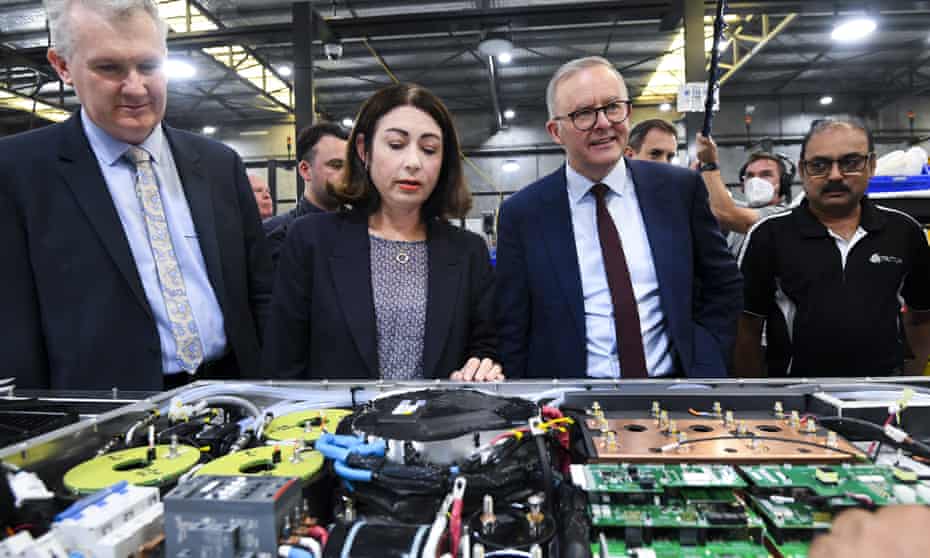Extract from The Guardian
With electricity bills soaring, a national Renewable Electricity Storage Target may be one way of achieving lower emissions – and lower prices

The paper, released on Tuesday by the independent group, said the market alone was unlikely to achieve either the bipartisan-supported net zero emissions goal by 2050 nor Labor’s pledge to lift Australia’s current 2030 emissions reduction goal by almost two-thirds. The former would require a 20-fold increase from existing storage levels.
In the absence of a carbon price, the federal government could introduce a storage goal, based on the Renewable Energy Target that spurred investment by requiring retailers to allocate a rising share of clean energy to 2020. The new target would be more effective than Labor’s election promise of investing a lot more on transmission.
“If I were [the new treasurer] Jim Chalmers looking for $20bn to knock off the budget, I would be sorely tempted to start with the Rewiring the Nation operation,” Bruce Mountain, the centre’s director and lead author of the report, said.
“It doesn’t need that amount of money, and shifting electricity at great cost over long distances is not where we’re headed” – economically or technologically, he said.
Energy markets could become an early source of strife for the incoming government, which inherits soaring prices in part because of outages of coal-fired power stations as well as from the effect of sanctions imposed on Russia for invading Ukraine.
In addition, the billionaire Mike Cannon-Brookes on Monday succeeded in upending plans by AGL Energy – the country’s biggest generator – to split into two. The climate activist wants to accelerate AGL’s coal exit and shift to more renewables and storage.
Excluding the 2000MW Snowy 2.0 pumped hydro project – still in early development – there are six grid-scale batteries operating, with a further nine under construction for a further 560MW, the report said. Another 49 announced or proposed projects would add 12 gigawatts more, but still well short of the 59GW of storage Aemo forecasts the grid will need by 2050.
“There’ll be a role for Snowy 2.0, but I think much of the in and out of the market, [the] day to day stuff, will be done by chemical batteries which can do the job much more quickly,” Mountain said.
The scheme would also be designed to reward only newcomers beyond a certain date, to ensure the target draws in capacity that would not have otherwise been added.
“The state governments have no reason not to like it. It doesn’t stand in their way,” Mountain said. “It gets the federal government doing something constructive, not tripping over the states on arguing about transition arrangements and transmission funding.”
Matt Kean, NSW’s energy minister, said he planned to work with the commonwealth to implement the state’s electricity infrastructure roadmap, including 2GW of long-duration storage.
His Victorian counterpart, Lily D’Ambrosio, said the change of government meant “we now have a great opportunity to better plan the energy transition at a national level and storage will continue to grow in importance”. She reserved judgment on the proposed scheme.
Tennant
Reed, Ai Group’s head of climate, energy and environment policy, said
the energy price hikes did not offer “particularly welcoming
housewarming presents for the new energy minister”.
He said the
storage goal – dubbed Renewable Electricity Storage Target, or REST –
did not necessarily supplant Labor’s “honking big thing on transmission”
and could complement it. “They don’t really stand or fall together.”
Reed said that while the mechanics of standing up such a target “shouldn’t be underestimated”, the former RET did provide relevant experience. Similarly, there was discussion during the Morrison era for a “capacity market” to ensure at least minimum generation capacity could also be extended to a storage goal.
“You can make a case for this kind of thing,” he said.
However, no matter how great the long-run benefits, “there will have a gross cost to somebody, and they will have upfront costs before they provide benefits.”
Dylan McConnell, an energy expert with Melbourne University, agreed there was “certainly a good argument for policy to support storage technologies”.
“It’s conceivable, perhaps even likely, that it might ultimately lower costs,” McConnell said. “But given the current retail price movements, it’s a politically challenging environment to advocate for potentially adding a surcharge to bills.”
No comments:
Post a Comment